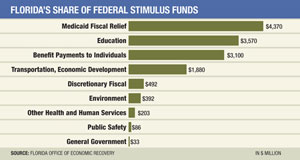The current recession is turning out to be severe, and Florida, with its dependence on housing, is particularly vulnerable. The most immediate help to the Florida economy will come from the federal stimulus bill. The American Recovery and Reinvestment Act of 2009 (ARRA) has a price tag estimated at $787 billion. The Florida Office of Economic Recovery estimates about $14.1 billion of these funds will flow into the state.
Most of the funds from the stimulus bill will go toward staving off education budget cuts, extending unemployment benefits and buttressing the state’s Medicaid program. However, there have been considerable funds allocated toward construction spending. From $49.3 billion in total transportation stimulus, Florida is to receive an estimated $1.35 billion in highway funding; its mass transit was awarded $310.7 million. Of the $1.1 billion allotted for total airport improvement grants at the national level, Florida will collect about $70 million.
ARRA also provides stimulus money for environmental public works. According to the Florida Dept. of Environmental Protection, the state will receive about $212 million in stimulus funding for improvements to the state’s water infrastructure. Of that total, $132.3 million has been set aside for wastewater and stormwater projects, with the remainder going to drinking-water facilities. The U.S. Army Corps of Engineers also will spend at least $250 million of stimulus funds in Florida, including $96 million on an Everglades restoration project.
The stimulus boost for buildings is smaller in scope and more dispersed than that for infrastructure. The most direct infusion will be $5.5 billion for the General Services Administration, including $4.5 billion to be directed at energy upgrades for federal buildings. GSA has plans to spend only about $70.7 million of its $4.5-billion building-renovation allotment in Florida; the largest item on the list is the $49-million “green” modernization of the Young Courthouse in Orlando.
The largest outlay for federal building renovation dollars will go to the Dept. of Defense. Of DOD’s $6.6 billion in stimulus funds, $250 million will go to various building projects in Florida.
Funding provided by the stimulus bill will turn into a gain what otherwise would have been a decline in Florida’s 2009 public works construction. However, the overall trend in construction will be downward. For buildings, the most discernible impact will come from energy-efficiency upgrades for federal buildings. The commercial-building sector, however, is not expected to derive much benefit from the stimulus bill. This shortfall will weigh heavily on Florida’s nonresidential construction, which is expected to decline 18% this year. The total value of Florida construction will drop 13%.
| QUARTERLY DATA, SEASONALLY ADJUSTED ANNUAL RATES | ANNUAL DATA | ||||||||||
|---|---|---|---|---|---|---|---|---|---|---|---|
| ITEM | 2007: 2Q | 2007: 3Q | 2007: 4Q | 2008: 1Q | 2008: 2Q | 2008: 3Q | 2008: 4Q | 2009: 1Q | 2008 | 2009 | % chg. |
| U.S. CONSTRUCTION STARTS | 650.1 | 640.4 | 574.3 | 618.1 | 575.7 | 567.5 | 446.6 | 388.6 | 552.0 | 457.7 | –17 |
| NONRESIDENTIAL | 238.3 | 238.6 | 230.7 | 282.9 | 244.9 | 242.2 | 204.3 | 159.3 | 243.6 | 197.2 | –19 |
| Commercial Buildings | 107.0 | 99.0 | 97.8 | 111.1 | 80.8 | 80.7 | 65.8 | 51.7 | 84.6 | 60.3 | –29 |
| Manufacturing Buildings | 18.9 | 27.6 | 11.8 | 37.6 | 36.1 | 35.6 | 11.3 | 7.2 | 30.2 | 18.3 | –39 |
| Institutional Buildings | 112.4 | 111.9 | 121.1 | 134.2 | 128.1 | 125.9 | 127.1 | 100.3 | 128.8 | 118.7 | –8 |
| RESIDENTIAL BUILDING | 273.9 | 252.4 | 225.6 | 191.3 | 174.9 | 157.9 | 123.1 | 94.8 | 161.8 | 111.4 | –31 |
| NONBUILDING CONSTRUCTION | 137.9 | 149.4 | 118.0 | 143.9 | 155.9 | 167.4 | 119.1 | 134.5 | 146.6 | 149.1 | +2 |
| FLORIDA CONSTRUCTION | |||||||||||
| Nonresidential | 4.6 | 4.5 | 3.8 | 3.6 | 4.2 | 3.5 | 2.2 | 2.3 | 13.5 | 11.0 | –18 |
| Residential | 6.6 | 5.3 | 3.6 | 3.6 | 3.3 | 3.2 | 2.1 | 1.6 | 12.2 | 7.3 | –40 |
| Nonbuilding | 3.3 | 2.3 | 2.0 | 2.1 | 1.2 | 1.8 | 1.2 | 2.5 | 6.3 | 9.5 | +50 |
| * MCGRAW-HILL CONSTRUCTION ANALYTICS | |||||||||||


Post a comment to this article
Report Abusive Comment